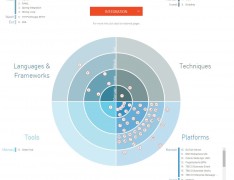Getting fintech on bank CIOs’ radar
 It is a well-known fact that banks have two types of technology: Cold War-era IBM mainframes running Cobol-based batch programmes and Evil Genius high-frequency trading systems creaming margins from ignorant ‘muppets’.
It is a well-known fact that banks have two types of technology: Cold War-era IBM mainframes running Cobol-based batch programmes and Evil Genius high-frequency trading systems creaming margins from ignorant ‘muppets’.
While both of these widely-held stereotypes contain an element of truth, the mundane truth is that any financial services operation will have a range of hardware and software systems of different vintages and spend a lot of time and money living with the consequences.
On top of the issues arising for managing these complex environments, chief information officers are faced with the problem of knowing what to do with emerging technologies such as blockchain – can they leave it to the technical architects, or do they need to get into the topic themselves and learn more about it to make a decision?
“The landscape of tech – and certainly what you would classify as digital tech – has exploded over the past two or three years, which is a problem: how do you grapple with that if you are the CIO in a large firm? How do you draw a mental map of where they all fit in? We needed a tool to understand the landscape,” says Sean O’Donnell, a technical director at Sapient Global Markets in London.
His answer to this was to create Sapient’s Technology Radar, mapping the technology stack into six areas: presentation layer, business services, data, integration, infrastructure and delivery. These are subdivided further as appropriate for each category, and the subdivisions are populated with products, services and technologies: infrastructure, for instance, breaks down into languages and frameworks (MSBuild, Perl), techniques (cloud orchestration, ITIL), tools (Citrix, Akamai) and platforms (Apache Tomcat, Amazon Web Services, Solaris).
The other problem was creating some sort of investment weighting for products and technologies – essentially a more granular version of an equity analyst’s buy-hold-sell rating. What they came up with covers a range of options arranged in rings: maintain-invest-watch-exit.
The results are plotted on a ‘radar screen’ with the maintain category at the centre and exit on the outer ring. The further from the centre an item is the closer it is to end-of-life. Continuing with the infrastructure layer example, you should be sunsetting Solaris, watching Amazon Redshift and Capistrano, investing in Apache Zookeeper, cloud migration and orchestration and maintaining IBM WebSphere.(Don’t know what Capistrano is? Click on the listing and you’ll be taken to the vendor home page: it’s a remote server automation and deployment tool. Written in Ruby, but can be adapted to any language. Apparently it “supports the scripting and execution of arbitrary tasks, and includes a set of sane-default deployment workflows”.)
“At one extreme we have an exit, which is basically it’s either end-of-life or where the vendor is saying they are no longer interested in it, or the general market is saying that it has fallen out of favour for whatever reason. On the counter side of that you have the ‘we’re definitely interested’ category that you continue to maintain, continue to evolve and continue to invest in,” he says. “In between those two extremes is where it gets interesting: the exit option is a no-brainer – in the user interface world it would be things like Silverlight or Flash/Flex – but the middle ones are where you have to make decisions. In the invest ring are things that you might have done some work with in terms of the technology or technique but now need to do more as it becomes mainstream. It could be to hire, or to partner, but you need to get some momentum going.”
In the watch ring, he says, are things on the horizon. “They are the things that could die a death or things are going to happen with them.”
To some extent this category covers what fintech investors would call unicorn hunting, but O’Donnell says that is has a more practical value, and has already been taken up both internally at Sapient and by clients.
The feedback that this has generated is being used to refine the model – the site has a contribution form that allows users to join in the ranking and so on – and also to generate insights into the trends.
“There has been a lot of commonality across areas, particularly in topics like UI, and the things that we have inferred from what has popped out of the data are that mobile is increasingly important in capital markets, where it wasn’t before,” O’Donnell says. “In capital markets, other than a few Mickey Mouse screens where you can book a trade, mobile is not really entrenched, and we are seeing a big change there. Along with the all-encompassing omnichannel it means the presentation layer is for mobile, is for tablet and the bring-your-own-device culture, so that takes you definitely into HTML5.”
Then there the fintech angle, where the existing categories are not quite so applicable and O’Donnell has had to “slice it slightly differently.”
“How do you identify the attributes of what the fintechs are and map them onto the radar if you are an incumbent organisation in the investment banking world?” he says. “Trying to understand what fintech is bringing, we have identified properties such as what technology it is innovating around – is it cloud, mobile, NFC, sensors, geo-location coupled with payments or whatever? Basically, what technologies is it using? The second property is what kind of business model they are trying to employ. A lot of the fintechs are taking a peer-to-peer model from something like Napster and then redeploying it in the payments world to try to change the game.”
A third characteristic of fintechs is harder to map, but nonetheless important. “There is a cultural perspective that you can extract that can be reemployed into your own organisation. The difference, I think, between old school fintech and the new fintech is around those things. One is technology exchange, but that’s just part of life and in10 years’ time we’ll look back and say it wasn’t all that novel a technology anyway. The more interesting thing is that rather than the business models that have always been used in this industry they are trying to turn on its tail and asking ‘what if you did this with it, how would that change the game?’ That cultural aspect is what is really different.”
Sean O’Donnell will be talking about this topic in a keynote session at Banking Technology‘s Fintech in Capital Markets Forum on 2 December 2015.












































